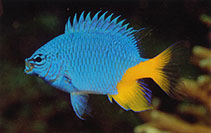
|
Chrysiptera giti Allen & Erdmann, 2008 Giti damselfish |

|
|
photo by
Allen, G.R. |
| Family: | Pomacentridae (Damselfishes), subfamily: Pomacentrinae | |||
| Max. size: | 3.6 cm SL (male/unsexed) | |||
| Environment: | reef-associated; marine; depth range 3 - 20 m | |||
| Distribution: | Western Pacific: Indonesia | |||
| Diagnosis: | Dorsal spines (total): 8-8; Dorsal soft rays (total): 10-11; Anal spines: 2-2; Anal soft rays: 12-12. Description: This species is distinguished by the following set of characters: D XIII,10-11; AII,12; pectoral rays 14-15; gill rakers on first branchial arch 6-7 + 15-16, total rakers 22-23; 13-17 tubed lateral-line scales; brilliant blue with yellow caudal-fin base and anal fin, the boundary between the blue and yellow colours extending obliquely from upper caudal-fin base to origin of anal fin is the color in life. Scales of head and body finely ctenoid. The new species most closely resembles C. hemicyanea, C. parasema, and an undescribed species (Chrysiptera species B) from New Guinea and northern Sulawesi. These species are generally allopatric over most of the geographic range, although C. hemicyanea co-occurs with the undescribed species at the Raja Ampat Islands off the extreme western end of New Guinea, and the same undescribed species is sympatric with C. parasema at eastern Flores in Indonesia (Ref. 74966). Body depth 1.9-2.2 in SL (Ref. 90102). | |||
| Biology: | Adults inhabit sheltered fringing reefs, usually in bays at depths between about 3 to 20 m. They occur in small aggregations; closely associated with branching formations of live coral, particularly Acropora spp. and the pocilloporid Seriatopora hystrix. The fish hovers a short distance above the substratum, presumably feeding on zooplankton (Ref. 74966). Oviparous, distinct pairing during breeding (Ref. 205). Eggs are demersal and adhere to the substrate (Ref. 205). Males guard and aerate the eggs (Ref. 205). | |||
| IUCN Red List Status: | Not Evaluated (N.E.) Ref. (130435) | |||
| Threat to humans: | harmless | |||
| Country info: |
|
|||